By Junex Doronio
MANILA — The Philippine Coast Guard (PCG) swiftly responded to the oil spill from the sunken motor tanker Terra Nova off Bataan, beginning the collection of oil on Friday, July 26, 2024.
The operation, expected to take seven days of siphoning, aims to counter the spread of the spill.
The Terra Nova capsized early Thursday, July 25, 2024, resulting in the death of one person.
PCG spokesperson Rear Admiral Armand Balilo stated that the incident occurred 3.6 nautical miles east of Lamao Point in Limay town around 1:10 a.m. on Thursday.
Sixteen of the seventeen crew members on board were rescued. The rescued crew claimed they secured the motor tanker’s valve before abandoning the ship.
“Based on the assessment by our Marine Environmental Protection personnel, considering the ship sank 34 meters deep, the siphoning can be completed within seven days,” Rear Admiral Balilo said.
He clarified that the oil spill originated from the working fuel of the motor tanker, not from the 1.4 million liters of stored industrial oil.
“Although only a small amount of oil was detected, we applied dispersant and collected the emulsified oil, indicating no leakage from the main tank,” Balilo noted.
“Oil spill booms, dispersants, and environmental protection personnel are already in the area,” he added.
(el Amigo/mnm)
By Junex Doronio
MANILA — Contrary to an earlier claim by the Philippine Navy, the Philippine Coast Guard (PCG) asserted on Wednesday, July 17, 2024, that China Coast Guard (CCG) 5901, the world’s largest coast guard ship known as “The Monster,” remains anchored at Escoda Shoal.
The 97-meter multi-role response vessel (MRRV) BRP Teresa Magbanua, named after a Visayan Katipunan heroine, has been stationed at Escoda Shoal since April, issuing radio challenges to the 165-meter CCG ship on an hourly basis.
“As of 7:30 in the morning on Wednesday, the latest image from our Coast Guard personnel shows that the CCG monster ship remains inside Escoda Shoal. It never departed and is still anchored there,” PCG spokesperson for the West Philippine Sea (WPS) Commodore Jay Tarriela said during the Kapihan sa Manila Bay forum at Cafe Adriatico in Malate, Manila.
He emphasized that the Chinese vessel has not left Escoda or Sabina Shoal since July 3.
“We have reported since last week that we monitored the presence of this CCG monster ship inside Escoda Shoal, anchored around 600 yards away from BRP Teresa Magbanua,” Tarriela added.
On Tuesday, July 16, 2024, Philippine Navy spokesperson for the WPS Rear Admiral Roy Vincent Trinidad said the CCG ship with hull number 5901 had exited the country’s exclusive economic zone.
“It is no longer off Escoda Shoal,” Trinidad stated during an interview with reporters after a regular press briefing at Philippine Air Force (PAF) headquarters. He also mentioned that no replacement ship had been sent.
Escoda or Sabina Shoal is located 75 nautical miles (about 140 kilometers) off Palawan and is considered to be within the Philippines’ 200-nautical-mile exclusive economic zone (EEZ).
(el Amigo/mnm)
By Junex Doronio
MANILA –Was it a “hit and run” case in the Subic Sea?
This question was raised on Friday after the Philippine Coast Guard (PCG) said they had identified two “vessels of interest” that may have collided with a Filipino fishing boat last July 3 in the waters of Subic, Zambales which left one fisherman still missing.
“Ang gusto natin malaman dito ay kung nakita ba nila [binangga] yung bangka, at kung nakita nila ay huminto ba o umiwas o anong ginawa nila, nag hit and run ba?”
PCG spokesperson Armand Balilo asked
He said that based on their vessel tracking system, the two vessels that passed through the collision site and are now considered vessels of interest are the Yong Fa Men and Melai Lan Hu, both of which are China-flagged bulk carriers.
The PCG said it has also written to the Chinese Embassy to request the China Maritime Safety Agency to cooperate in their investigation.
The said vessels are now in Adang Bay in Indonesia.
Fisherman Robert Mondeñedo was rescued, but authorities are still searching for his companion and brother Jose Mondeñedo.
According to the Philippine Coast Guard (PCG) report, the two brothers departed from Barangay Wawandaue in Subic on July 1 aboard the fishing banca “John Robert” to reach their payao near Sampaloc Point for a fishing trip.
But on July 3 (Wednesday), around 3 p.m., an unidentified vessel collided with their boat.
The PCG reported that Robert survived the collision by clinging to their payao for three days until he was rescued by another fishing boat, “Irish Mae,” at around 8 a.m. on July 6.
(el Amigo/mnm)
By Junex Doronio
MANILA — In times of crisis, humanity prevails.
This encapsulates the incident when amid the aggressive actions of China Coast Guard (CCG) in the West Philippine Sea, it finally showed compassion and sense of humanity when it offered to help the Philippine Coast Guard (PCG) in rescuing the two fishermen who sustained injuries after their boat’s engine exploded near Bajo de Masinloc on Saturday (29 June 2024).
PCG spokesperson Rear Admiral Armand Balilo said the CCG eventually allowed their multi-role response vessel (MRRV) through after hearing about the explosion.
“Nung una binlock muna pero nung after nila malaman ‘yung reason they even offered help to rescue pero tayo ang nag-rescue,” the INQUIRER.net quoted Balilo as saying in a phone interview.
He said eight fishermen were aboard the ill-fated boat about 10 nautical miles from Bajo de Masinloc, also called Scarborough Shoal and Panatag Shoal, when the explosion happened about 2 p.m.
There were no details what caused the explosion.
(el Amigo/mnm)
By Junex Doronio
MANILA — Calling it an intimidation tactic, the Philippine Coast Guard (PCG) has assailed China’s new regulation allowing its coast guard to detain trespassers in what it considers its territorial water without trial.
This was learned from an article published by the South China Morning Post on May 16, Thursday.
“This rule only sought to discourage Filipinos from doing legitimate activities in the West Philippine Sea. Isa na namang pananakot ito ng Chinese government, to discourage these kinds of activities,” PCG spokesperson for the West Philippine Sea (WPS) Commodore Jay Tarriela said.
The article in the South China Morning Post said that this was “the first time a specific regulation has clarified the Coast Guard force’s law enforcement procedure for administrative detentions.”
“Definitely these are things na masasabi nating illegal na aksyon ng China. The mere fact that they claim all sovereignty over our exclusive economic zone at ang jina-justify lang naman nila ay yung imaginary nine-dash line nila. Definitely, it is not only the Philippines that will be affected by this kind of domestic law na ginawa nila,” Tarriela quipped.
He added that they were keen on protecting Filipino fishermen notwithstanding the new rule that seemed to be intimidating.
“We will still strategically deploy our Coast Guard vessels to ensure the safety and security of Filipino fishermen. Ang Coast Guard ay mananatiling nagpapatrolya dito. Sisiguraduhin na ang mga mangingisdang Pilipino natin ay malayang makakapangisda sa exclusive economic zone natin,” Tarriela stood firm.
(el Amigo/MNM)
MANILA – The Philippine Coast Guard (PCG) dispatched two more vessels to escort the “Atin Ito” convoy to Bajo de Masinloc, ensuring the safety of the Filipino civilian movement on Wednesday (15 May 2024).
During a press conference hosted by the Philippine Information Agency (PIA) in Quezon City, PCG Commodore Jay Tarriela, spokesperson for the National Task Force for the West Philippine Sea (NTF-WPS), said that the two vessels will join the BRP Bagacay, which was sent ahead to rendezvous with the convoy before reaching Bajo de Masinloc.
“We also dispatched an aircraft to monitor the situation in Bajo de Masinloc,” Tarriela added.
Currently, the civilian convoy has departed Zambales and is en route to the West Philippine Sea (WPS).
In a Viber message to reporters, PCG spokesperson Rear Admiral Armando Balilo identified the two ships as BRP Panglao and BRP Boracay, both 24-meter patrol fast boats.
“BRP Boracay is already in Subic. BRP Panglao is also on its way,” Balilo said.
He added that a PCG aircraft remains on standby to monitor the civilian mission.
‘Atin Ito’ Not Sanctioned by PH Gov’t
However, Tarriela clarified that the “Atin Ito” convoy is a civilian mission and is not sanctioned by the Philippine government.
“This decision of ‘Atin Ito’ to sail is voluntary. We did not force them; this is a civil society initiative,” he said.
Nonetheless, PCG Commandant Admiral Ronnie Gil Gavan has ordered the dispatch of the PCG ships and aircraft as part of the PCG’s duty to safeguard Filipinos in the country’s waters.
“The PCG will ensure the safety of Filipinos sailing within our exclusive economic zone (EEZ),” Tarriela emphasized.
He noted that the additional PCG vessels were dispatched in response to the presence of an unknown number of Chinese Coast Guard (CCG) vessels currently awaiting the civilian convoy in Bajo de Masinloc.
“There’s no denying that more CCG vessels have been deployed. We can confirm Ray Powell’s statement that there are several CCG vessels guarding the area,” he said.
The convoy to Bajo de Masinloc was organized by the Atin Ito Coalition, which aims to deliver provisions to other Filipino fishermen in the area.
On its way to the shoal, the convoy also plans to install buoys marked with “WPS, Atin Ito (This is Ours)” in certain areas of the WPS.
(el Amigo/MNM)
By Junex Doronio
MANILA — Legendary Chinese military genius once said: “Let your plans be dark and impenetrable as night, and when you move, fall like a thunderbolt.”
This seems to be the playbook of China as it has been dumping crushed corals near Escoda (Sabina) Shoal in apparent preparation to build an artificial island on top of the maritime feature, which is much closer to Palawan than the contested Ayungin Shoal in the West Philippine Sea.
This, however, did not escape from the watchful eyes of the Philippine Coast Guard (PCG) even as a “swarm” of over 30 Chinese militia vessels, aside from China’s research ships, Navy vessels, and a helicopter, were monitored during the 26 days deployment of BRP Teresa Magbanua at the Escoda Shoal.
“Dito kumbaga nagsisimula pa lang. So kung sasabihin natin na itong pagdu-dump ng coral na ginawa nila sa Sandy Cay has allowed them (China) to expand itong land area, surface area na ito as artificial island, then most likely kung hindi natin imo-monitor ito, at hindi natin babantayan ito, baka sa mga susunod na buwan, magulat na lang din tayo na sa Sabina Shoal, ay malalaki na rin ang mga isla na ginawa nila,” PCG spokesperson for the West Philippine Sea (WPS) Commodore Jay Tarriela said.
He aired suspicion that for its island-building activities, China uses corals as “pantambak (landfill).”
“That means they have to kill all the corals, as many corals as possible, for them to use that as a foundation for their island reclamation,” the PCG spokesman said during the Saturday News Forum at Dapo Restaurant in Quezon City.
For more than 26 days, the BRP Teresa Magbanua, the largest vessel in the PCG fleet, is deployed to Escoda Shoal, just 75 nautical miles or about 139 kms. from the main Palawan island.
In comparison, Ayungin Shoal is 106.3 nautical miles or 197 kms. from Palawan.
The PCG said both Escoda Shoal and Ayungin Shoal are well within the 200-nautical mile (370.4 kms.) Philippine exclusive economic zone (EEZ), parts of which overlap with Beijing’s expansive claims over the South China Sea.
(el Amigo/MNM)
MANILA — Amid escalating tensions in the West Philippine Sea (WPS), the Philippine Coast Guard (PCG) is actively seeking support from Australia to bolster its maritime capabilities. The PCG is eyeing the acquisition of two patrol vessels from Australia’s global shipbuilder and defense prime contractor.
The Guardian-class 39.5-meter patrol boat, manufactured by Austal, has piqued the interest of the PCG. This vessel, renowned for its effectiveness in maritime operations, is particularly attractive to the Philippine government due to Austal’s shipyard in Balamban, Cebu.
Australia’s provision of such patrol ships to small South Pacific Ocean countries under its Pacific Maritime Security Program underscores its commitment to enhancing regional maritime security. While these patrol boats are initially armed with light weapons, they possess the capability for further upgrades, including medium-caliber guns like 25/30 mm chain guns and 12.7 mm heavy machine guns.
The acquisition of the Guardian-class patrol boats by the PCG may be facilitated through various means, including outright purchase, official development assistance grants, or loans from Australia.
This initiative supplements the Philippine government’s broader modernization efforts aimed at fortifying its maritime defense capabilities. It is separate from the procurement of three new ships funded under the 2024 national budget, specifically designated for defending the West Philippine Sea.
Furthermore, the realignment of funds from the Office of the Vice President and the Department of Education to intelligence and security agencies underscores the government’s commitment to addressing escalating threats in the WPS. Lawmakers advocate for increased allocations to the PCG, recognizing its pivotal role in safeguarding the country’s waters.
The PCG’s journey towards modernization has been marked by collaboration with various allies, including Japan, France, and the United States. These partnerships have significantly contributed to expanding the PCG’s fleet and enhancing its maritime capabilities.
As tensions persist in the WPS, the Philippines continues to seek strategic alliances and technological advancements to safeguard its territorial integrity and maritime interests.
(el Amigo/MNM)
By Junex Doronio
MANILA — This is what friends are for.
Being an old reliable ally, the United States assumed the role of “Big Brother” as it called on China on Wednesday (06 March 2024) to halt its provocative actions against the Philippines in the wake of the reported collision between the Philippine Coast Guard (PCG) vessels and the much larger China Coast Guard (CCG) ships.
On Tuesday (05 March 2024), the US took notice that China Coast Guard vessels caused two collisions with Philippine boats and water cannoned one of them, leaving four crew injured during a resupply mission in waters around Ayungin Shoal.
With this latest harassment within the Philippines’ exclusive economic zone (EEZ), the US State Department condemned China’s actions, which “show disregard for the safety and livelihoods of Filipinos and international law.”
Agency spokesperson Matthew Miller cited an international tribunal 2016 ruling that China has “no lawful maritime claims” to the waters around Ayungin, which is “clearly within the Philippines exclusive economic zone.”
“As provided under the 1982 Law of the Sea Convention, the 2016 arbitral decision is final and legally binding on the PRC and the Philippines, and the United States calls upon the PRC to abide by the ruling and desist from its dangerous and destabilizing conduct,” Miller said in a press conference.
He added that the US-Philippines Mutual Defense Treaty extends to armed attacks on Philippine vessels, including those of the Coast Guard, anywhere in the South China Sea.
The agreement requires Washington to support Manila in the event of an attack.
But Miller declined to say whether the treaty could be triggered by the latest incident.
“I’m not going to speculate or get out ahead of any discussions with – in this regard,” the US State Department official said.
For their part, the CCG stood firm that it “took control measures” against Philippine ships’ “illegal intrusion” in waters around the shoal.
(el Amigo/MNM)
By Junex Doronio
MANILA — Following the alert issued by a United States maritime analyst that two Chinese research vessels were detected “loitering” at the resource-rich Philippine Rise east of Luzon, the Philippine Coast Guard (OK CG) on Monday has deployed the BRP Gabriela Silang (OPV-8301) for a two-week mission to Batanes and Benham Rise.
PCG Spokesperson, CG Rear Admiral Armando Balilo said the BRP Gabriela Silang will patrol for the vicinity waters to conduct maritime domain awareness, intensify Coast Guard presence in Northern Luzon, and monitor local fishermen.
“We will also check the reported Chinese research vessels in Benham Rise,” CG Rear Admiral Balilo quipped.
Department of National Defense (DND) Secretary Gilberto “Gibo” Teodoro Jr. had earlier called for increased military presence in Batanes, calling the northernmost province “the spearhead of the Philippines.”
The Naval Forces Northern Luzon (NFNL) said the DND chief wants more structures in the province after inspecting Naval Detachment Basco, Naval Detachment Mavulis, Itbayat Airport, and the Multi-Agency Facility in Mahatao.
Meanwhile, it was learned that air assets of the Coast Guard Aviation Force are on standby for possible augmentation, specifically in performing aerial surveillance.
To recall, former United States Air Force official and ex-Defense Attaché Ray Powell revealed on his X (formerly Twitter) post that Chinese vessels Haiyang Dizhi Liuhao and Haiyang Dizhi Shihao sailed from Longque Island in Guangzhou province on February 26 and moved east-southeast through the Luzon Strait.
Based on the map Powell showed, the Chinese vessels sailed between Basco, Batanes, and islands off the main island of Luzon.
(el Amigo/MNM)
By Junex Doronio
MANILA — Alarmed by possible online security breach, the Philippine Coast Guard (PCG) on Tuesday (27 Feb 2024) said it has consulted with the Philippine National Police (PNP) Anti-Cybercrime Group to trace the culprit of the hacking of its Facebook page.
The PCG disclosed that on Monday night (26 February 2024), the PCG’s Facebook page started to post malicious videos after an “unknown entity” gained access to the account.
“After initial consultation with the Philippine National Police (PNP) Anti-Cybercrime Group, the CGPAS (Coast Guard Public Affairs) considers the possibility of online security breach through malware (malicious software),” PCG spokesperson Rear Admiral Armando Balilo said.
The PCG official said the unknown entity did not leave any digital trace on the official email address and the mobile phone used to establish a security key as an additional layer of online security protection.
Balilo added that the CGPAS already coordinated with Meta and provided the needed details to regain access to the page.
“The CGPAS is also set to meet with Coast Guard Weapons, Communications, Electronics, and Information System Command (CGWEIS) to conduct backend operations for page recovery,” he said.
The PCG Facebook page has yet to be recovered as of posting time.
(el Amigo/MNM)
By Junex Doronio
MANILA — Given the escalating tension between the Philippine Coast Guard (PCG) and the Chinese vessels in the West Philippine Sea, the Armed Forces of the Philippines (AFP) on Monday (26 Feb 2024) said it is ready to support the country’s coast guard.
The AFP’s statement came out on the heels of the latest incident between PCG and Chinese vessels in Bajo de Masinloc or Scarborough Shoal.
“The AFP supports the maritime law enforcement operation of the PCG and other maritime law enforcement agencies. For our part, any challenges faced by foreign forces are addressed with utmost professionalism and we will practice maximum tolerance,” AFP spokesperson Col. Francel Margareth Padilla told reporters in a Viber message.
At the same time, the AFP maintained that it would practice maximum tolerance in “addressing challenges from foreign forces.”
On Sunday (25 February 2024), the Philippines accused the China Coast Guard (CCG) of attempting to block the Bureau of Fisheries and Aquatic Resources’ BRP Datu Sanday, which was delivering supplies to fishermen near Bajo de Masinloc last February 22.
(el Amigo/MNM)
By Junex Doronio
MANILA — Undaunted by the continuing harassment by China, the Philippine Coast Guard (PCG) on Saturday (24 Feb 2024) revealed the increasing number of Chinese vessels in the West Philippine Sea (WPS) and so far recorded 4 Chinese Coast Guard vessels, 3 People’s Liberation Army (PLA) Navy vessels, 7 Maritime militia vessels, and one Chinese fishing vessel.
The Bureau of Fisheries and Aquatic Resources (BFAR) also recorded 3 dangerous maneuvers by the Chinese Coast Guard, Chinese maritime militia, and, for the first time, a Chinese fishing vessel participated in blocking the BFAR vessel.
“We can fairly say na merong significant number of increase, pero I think probably the other reason is dahil sa presence na natin ngayon as what the president directed the Philippine Coast guard and BFAR to have a rotational deployment in Bajo de Masinloc, so probably this is the reason why there’s an increasing number of Chinese Maritime militia,” PCG spokesperson for the WPS Commodore Jay Tarriela said.
It was gathered that from the entrance of Bajo de Masinloc, BFAR personnel spotted the People’s Liberation Army Navy (PLAN), a Chinese warship, around 11 in the evening of February 21, marking what the BFAR said was the early shadowing.
“This is the first time that the Philippine government monitored the presence of a Chinese fishing vessel, not a Chinese maritime militia. This is the first time a Chinese fishing vessel participated in the blocking and shadowing operation to prevent the BFAR vessel from moving forward or getting closer to Bajo de Masinloc,” Tarriela said.
He added that the presence of Chinese fishing vessels could indicate additional troops deployed by China at Bajo de Masinloc.
(el Amigo/MNM)
By Junex Doronio
MANILA — Philippine Coast Guard (PCG) spokesperson Commodore Jay Tarriela on Thursday (22 Feb 2024) branded as “inaccurate” China Coast Guard’s (CCG) claim that it repelled a Bureau of Fisheries and Aquatic Resources (BFAR) vessel near Scarborough Shoal or Bajo de Masinloc.
Tarriela said the BFAR vessel, BRP DATU SANDAY, “is actively ensuring the security of Filipino fishermen in that area,” as of this posting.
“Interestingly, some of our media friends are embedded onboard the BFAR vessel, and their forthcoming reports upon completion of the mission will confirm the accuracy of our statement,” the PCG official said.
In a post on X by China-backed Global Times, it claimed that the CCG had “repelled” the Philippines’ BFAR Ship 3002.
PCG officials cited a ruling by an international court in The Hague in 2016 that ruled that the Philippines has fishing rights over Scarborough Shoal in the West Philippine Sea.
(el Amigo/MNM)
By Liezelle Soriano
MANILA — Philippine Coast Guard (PCG) spokesman for WPS Commodore Jay Tarriela said on Saturday (17 Feb 2024) that President Ferdinand Marcos “Bongbong” Marcos Jr. has ordered them to maintain the country’s presence in the West Philippine Sea (WPS) amid China’s continued presence in Philippine waters.
“We know for a fact na ang ‘Bajo de Masinloc’ is a traditional fishing ground for the Filipinos particularly ang ating mga kababayan sa Zambales, sa Pangasinan at in different parts dito sa coastal area ng Northern Luzon,” Tarriela said.
“Dahil dito, it is now the guidance of our President to have a rational deployment between the Philippine Coast Guard and the Bureau of Fisheries and Aquatic Resources to maintain our presence in Bajo de Masinloc,” he added.
Tarriela explained the PCG has maintained its presence in Philippine waters from February 1 to 9 while the Bureau of Aquatic Resources (BFAR) deployed its personnel after their shift in conducting the rotational deployment.
“So dinikitan siya at from then on, hindi na siya binitawan. The entire presence ng BFAR vessel dito it was consistently shadowed by the Chinese Coast Guard vessel particularly this one – China Coast Guard 3105,” he added.
(el Amigo/MNM)
By Junex Doronio
MANILA — As if playing cat and mouse, eight Chinese vessels were spotted by the Philippine Coast Guard’s BRP Teresa Magbanua on its nine-day patrol of Bajo de Masinloc, specifically in Panatag and Scarborough shoals.
This was revealed by the Philippine Coast Guard (PCG) on Sunday 11 Feb 2024), saying the BRP Teresa Magbanua was deployed to Bajo de Masinloc earlier in the month to help secure Filipino fishermen in the shoal in the West Philippine Sea (WPS).
According to PCG, the Philippine vessel “professionally engaged” the 4 China Coast Guard (CCG) and 4 Chinese Maritime Militia ships “reiterating the clear and principled position of the Philippines by maritime law.”
PCG spokesperson for WPS Commodore Jay Tarriela, posted on X (formerly Twitter) that the CCG vessels 3105, 3302, 3063, and 3064 “shadowed the PCG vessel on more than 40 occasions”, at one point being just 176 meters from the Magbanua.
“The CCG vessels performed dangerous and blocking maneuvers at sea against BRP Teresa Magbanua four times, with the CCG vessels crossing the bow of the PCG vessel twice, recklessly disregarding the ‘Convention on the International Regulations for Preventing Collisions at Sea’(COLREGS) once again,” the PCG maintained.
(el Amigo/MNM)
By Junex Doronio
MANILA — Maintaining that the Philippine Coast Guard (PCG) will continue to expose China’s aggression, PCG spokesperson Commodore Jay Tarriela on Wednesday (07 Feb 2024) emphasized their transparency efforts to raise public awareness of China’s “illegal actions” in the West Philippine Sea (WPS).
At the same time, the PCG official called on other smaller countries to be united and rally like-minded states to challenge acts that defy international law and disrupt the international ruling.
“Simply condemning China’s aggressive behavior through public statements may not be enough to hold Beijing fully accountable. The international community must explore alternative measures to compel China to adhere to international law, going beyond just imposing reputational cost,” Tarriela said in a forum held in San Juan City.
He pointed out that the world community must seek alternative measures to compel China to abide by international law amid its continuing aggression in the WPS.
“Without tangible consequences, China may continue its aggressive actions in the region and our transparency initiative may be perceived as an endless stream of complaints against China,” Tarriela quipped.
He added: “Without such exposure, smaller nations like the Philippines, will continue to be targets of bullying by more powerful and larger countries like China.”
The PCG spokesperson also stressed the importance of exposing the excesses of bigger countries.
“If we do not expose their illegal actions, countries like China and Russia will become increasingly emboldened to bully smaller nations knowing that they will face no consequences or accountability. Their unlawful actions will go unpunished if like-minded states that support the international rules-based order remain unaware,” Tarriela concluded.
(el Amigo/MNM)
By Junex Doronio
MANILA — Trashing China’s insinuation that the United States and other allies may have a “hidden agenda” on the West Philippine Sea (WPS) issue, the Philippine Coast Guard (PCG) on Thursday said the country will continue to welcome countries that support its interests.
PCG spokesperson Commodore Jay Tarriela stressed that the Philippines will keep its vigilance against “bullies” and called out China for blaming the actions of the Philippines as well as the US for the rising tensions in the South China Sea.
“While it is true that there is no such thing as free lunch, unlike China, our allies do not take away our lunch especially if it is rightfully ours,” Tarriela said in a post on X (formerly Twitter).
He was reacting to an editorial article in the Chinese government-supported publication Global Times.
The article read, “The Philippines must remain vigilant against the ‘enthusiasm’ displayed by the US and some other countries. There is no such thing as a free lunch, and behind the US’ “enthusiasm” lies a hidden agenda.”
It can also be noted that recently, Chinese state media People’s Daily also published a commentary accusing the Philippines of infringing on China’s territory, spreading false information, and colluding with other countries to cause trouble.
“Until now, the [People’s Republic of China] has not come to terms with the fact that their fabricated narratives and baseless claims about the alleged aggressive actions of the Philippines are not that convincing,” Tarriela quipped.
Meanwhile, the Armed Forces of the Philippines (AFP) also said the Philippines is not provoking conflict in the South China Sea.
“[The] Philippines is not provoking conflict. We follow international law and we are only implementing our domestic law,” AFP spokesperson Colonel Medel Aguilar pointed out.
He further said the Philippines is not conducting activities that will put vessels and seafarers in danger and instead accused China of performing dangerous maneuvers that sometimes result in collisions at sea.
“They are the ones committing all the violations,” Aguilar retorted.
He noted that the Philippines was just conducting activities within its territorial waters and exclusive economic zone (EEZ).
(IAmigo/MNM)
MANILA — A member of the Philippine Coast Guard (PCG) is now in critical condition, declared brain dead following an incident during a Water Search and Rescue (WASAR) training session at Sangley Point, Cavite City, on a Saturday afternoon.
The victim, identified as Mon Caguay y Baglinit, 30, a native of Tabuk, Kalinga Apayao, and a PCG member, is presently undergoing treatment at the San Pedro Calungsod Medical Center, Cavite.
Romana Caguay, the mother of the victim, has already filed a formal complaint with the Cavite City Component Police Station, alleging that her son drowned during the WASAR training organized by PCG personnel stationed at Sangley Point, Cavite City.
The incident occurred at approximately 3:30 PM on November 16, 2023, in the seawater of Manila Bay, Barangay 48, Sangley Point, Cavite City.
In addition to the local police, the family intends to seek further assistance by filing a complaint with the National Bureau of Investigation (NBI), particularly against the PCG-MSSC (Philippine Coast Guard-Maritime Safety Services Command) training staff.
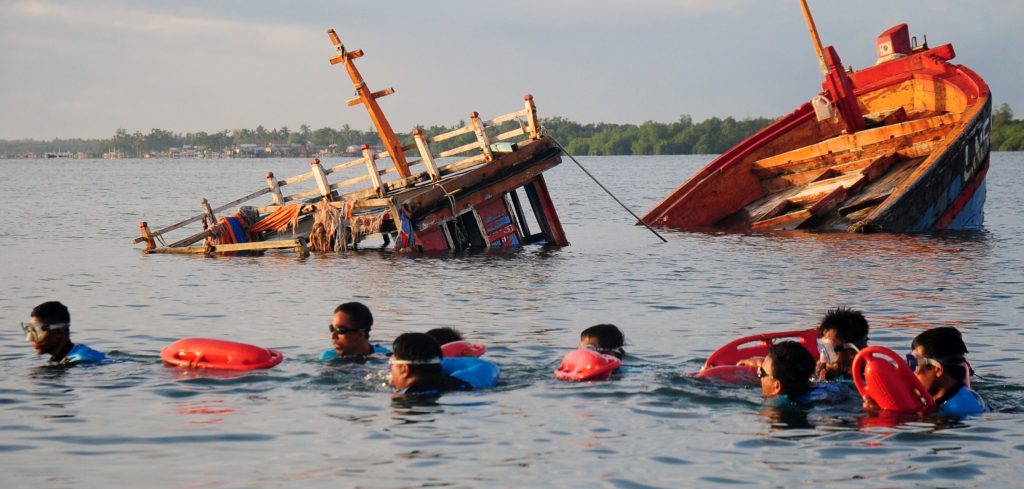
(Benjamin Cuaresma/ai/mnm)
On Saturday, October 14, 2023, personnel from the Philippine Coast Guard (PCG) showcased their capabilities in a demonstration held in front of the youth from Baseco, located in Tondo, Manila. This event took place at Pier 13 in the Port Area of Manila during a visit by the BRP Teresa Magbanua (MRRV-9701) as part of a concurrent tour.
Shown here are images capturing the PCG’s demonstration in front of the children from Baseco, Tondo, Manila:
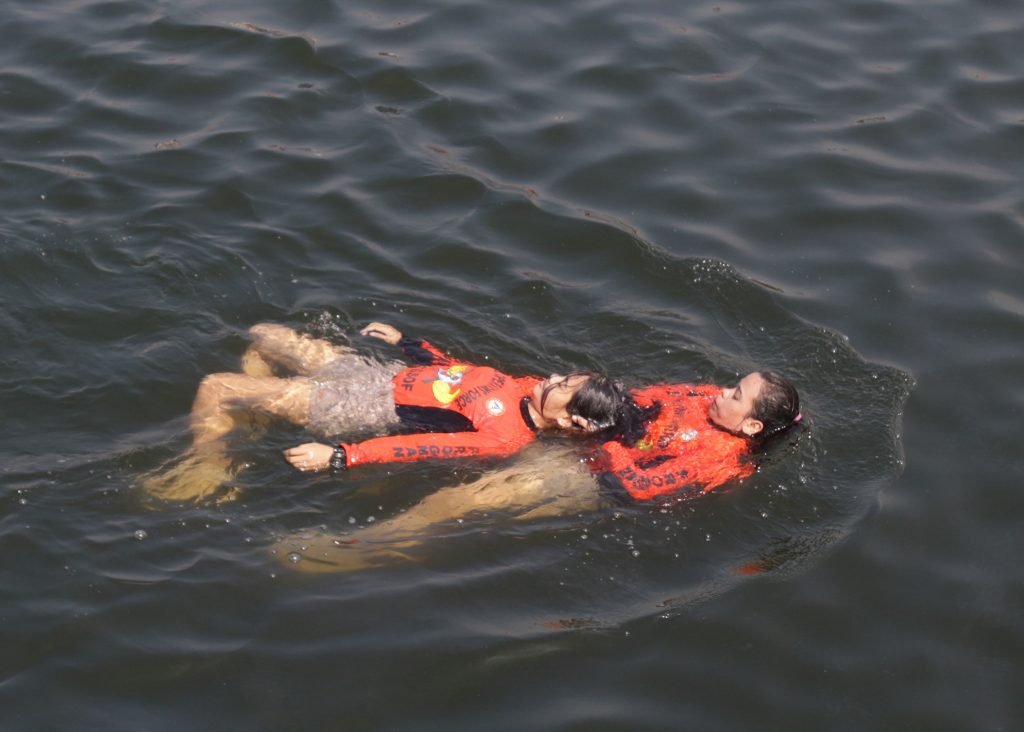
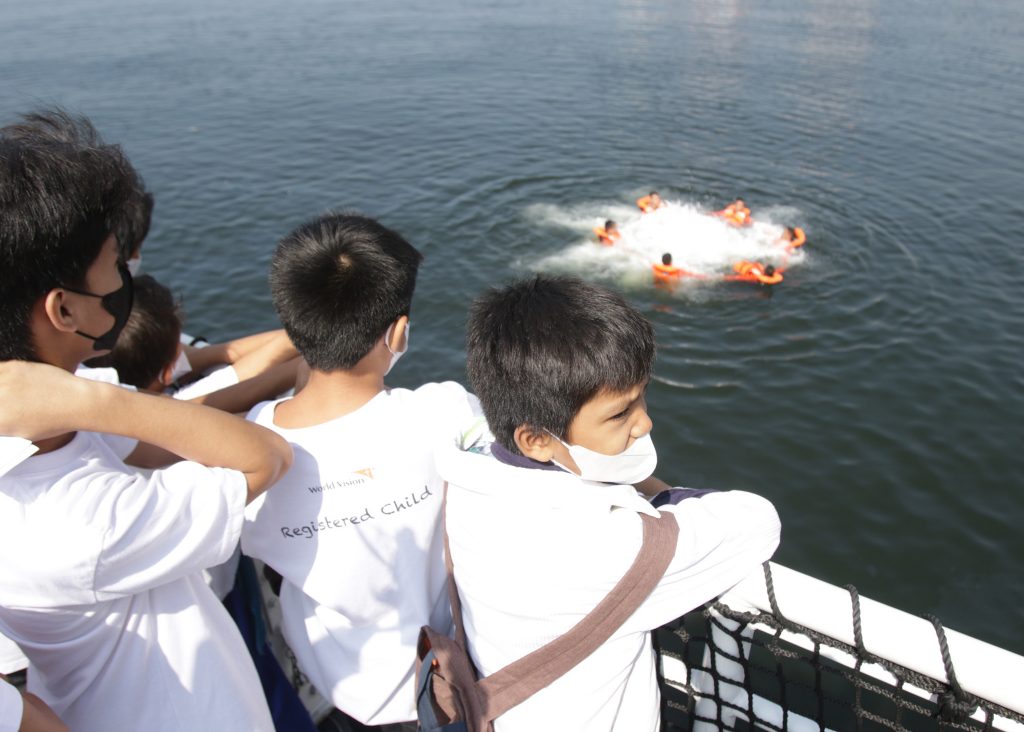
The event was overseen by Commodore Armand Balilo, the spokesperson for the Philippine Coast Guard, and also featured the presence of Gerald Anderson, a prominent figure within the Philippine Coast Guard.
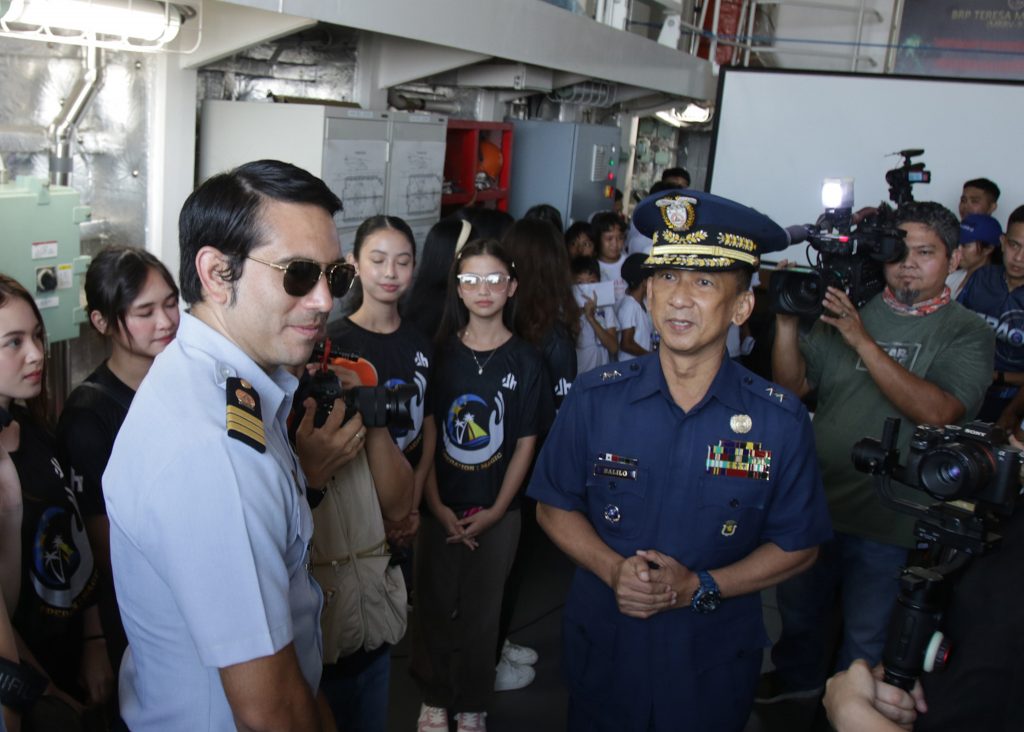
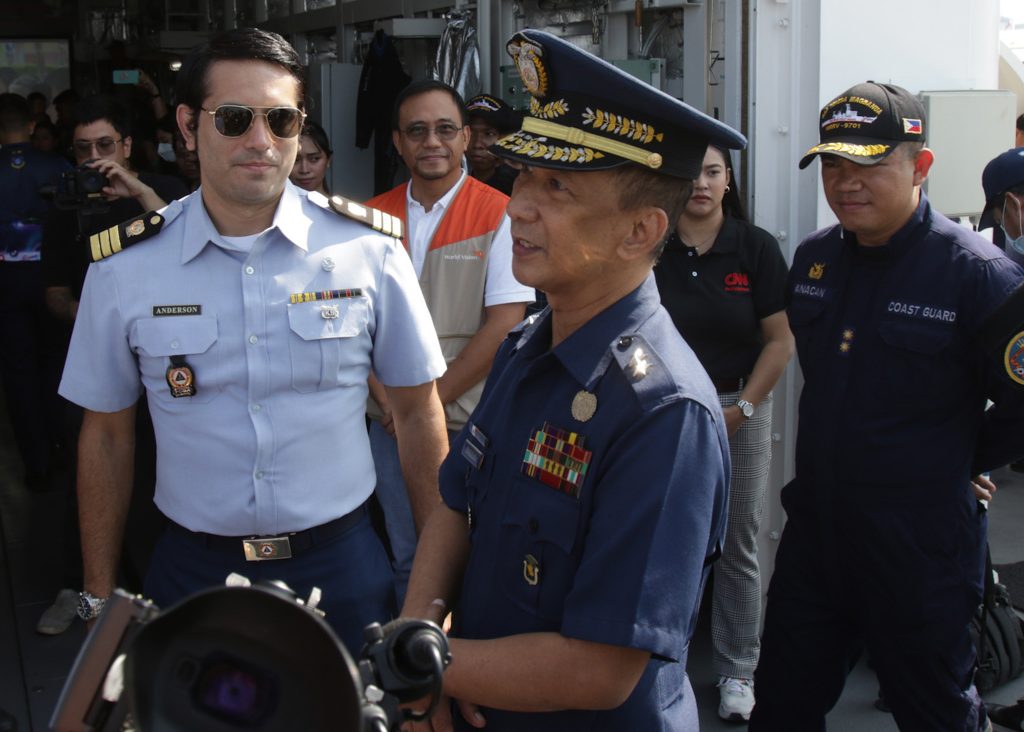
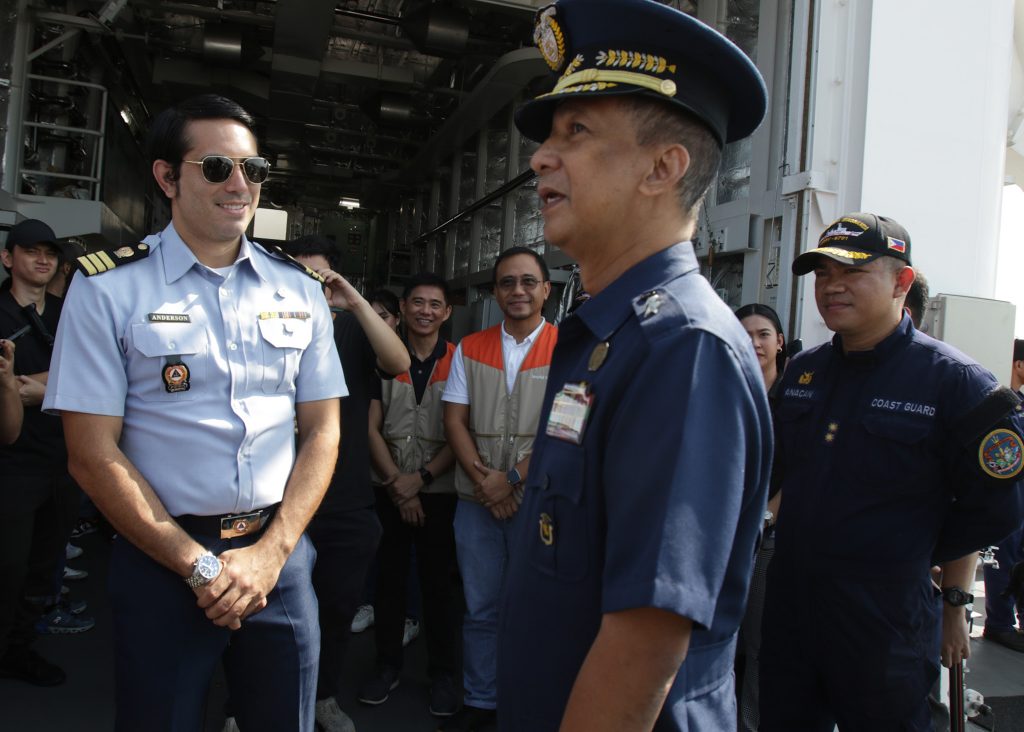
(Benjamin Cuaresma/ai/mnm)
